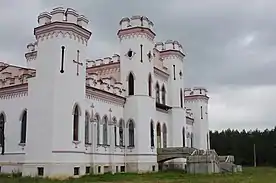Kosava
| |
|---|---|
 Pusłowski palace | |
 Coat of arms | |
 Kosava | |
| Coordinates: 52°45′N 25°09′E / 52.750°N 25.150°E | |
| Country | Belarus |
| Region | Brest Region |
| District | Ivatsevichy District |
| Mentioned | 1494 |
| Population (2023)[1] | |
| • Total | 1,872 |
| Time zone | UTC+3 (MSK) |
| Postal code | 225262 |
| Area code | +375 1645 |
| License plate | 1 |
Kosava or Kossovo (Belarusian: Косава; Russian: Коссово; Lithuanian: Kosovas; Yiddish: קאסעוו, romanized: Kosev), formerly known as Kosava-Palyeskaye (Belarusian: Косава-Палескае, romanized: Kosava-Palieskaje, Polish: Kosów Poleski), is a town in Ivatsevichy District, Brest Region, Belarus.[1] As of 2023, it has a population of 1,872.[1]
The nearby village of Merechevschina is the birthplace of Tadeusz Kościuszko. Kosava is the birthplace of Rabbi Avraham Yeshayahu Karelitz. Nearby is the ruined Kosava Castle, built by the Pusłowski family in 1830, and a replica of Tadeusz Kościuszko's house in Mereczowszczyzna.
History
| External image | |
|---|---|
The first settlements in the area are known since the 10th and 11 centuries as part of Kievan Rus'. The first mention of the town was in 1494, when it was part of the Polish–Lithuanian Commonwealth. After 1795, it became part of the Russian Empire. From 1915 to 1918, the town was under German occupation and then was occupied by Poland after the Polish–Soviet War. On 3 February 1927, as Polish newspaper Robotnik reported, Polish policemen shot manifestation of peasants that claimed to release imprisoned deputies.
References
- 1 2 3 "Численность населения на 1 января 2023 г. и среднегодовая численность населения за 2022 год по Республике Беларусь в разрезе областей, районов, городов, поселков городского типа". belsat.gov.by. Archived from the original on 17 April 2023. Retrieved 10 August 2023.
External links
